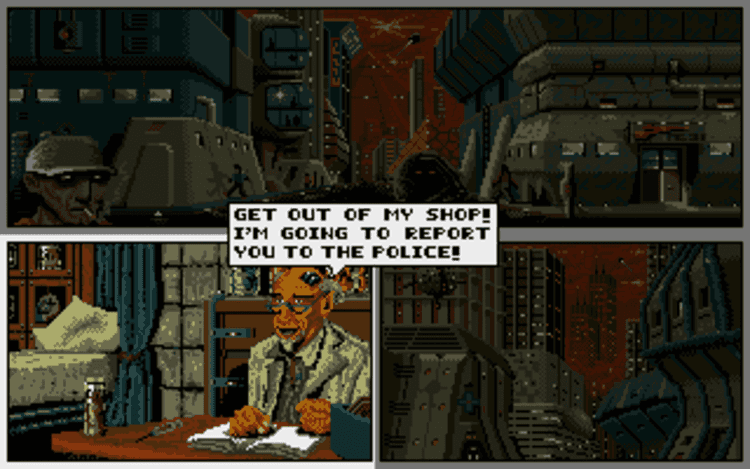
B.A.T., published by the visionary team at Ubi Soft, fuses point-and-click investigation with deep role-playing mechanics, letting players shape a neon-lit future through choice and strategy. This classic game invites you to infiltrate a labyrinthine cityscape reminiscent of genre milestones like Neuromancer and Shadowrun, yet it carves its own identity with dynamic character development and open-ended missions. Whether you’re navigating shady back alleys, hacking terminals, or engaging in tactical combat, B.A.T. keeps you immersed from start to finish. Experience the timeless thrill of cyber-espionage and play this iconic adventure game online, free from platform limits and always ready for another daring infiltration.
When Computer’s Dream collaborated with Ubisoft at the tail end of the eighties, their goal went beyond producing another point-and-click adventure; they wanted to immerse players in a sprawling, neon-lit cosmopolis that felt alive and unpredictable. B.A.T. thrusts you into the leather boots of a seasoned agent from the Bureau of Astral Troubleshooters, an interstellar organization that solves crises before they spiral across the galaxy. From the moment the opening pixel skyline scrolls past, the game establishes a cyberpunk mood that rivals classic literature in density and builds a fierce appetite for exploration.
Instead of serving static background art, the city pulses with day-night rhythms, fluctuating market prices, and citizens who respond differently depending on the hour. Cafés close, smugglers trade in shadowy alleys, and billboards advertise ever-changing tech fads. All of these details combine to create an illusion of a living habitat—one that feels more advanced than many later titles. While contemporaries such as The Secret of Monkey Island leaned on comedic fantasy, this game chose gritty realism, unafraid to blend the tropes of science-fiction noir with layered role-playing depth.
The effect is immediate: conversations carry weight, credit chits are scarce, and a single impulsive insult may trigger a firefight in a narrow corridor. Every scene strengthens that core tenet of cyberpunk storytelling: technology empowers and endangers in equal measure. Players find themselves balancing ethics against efficiency, often deciding whether to force their way past an obstacle or invest time in gathering reliable intel. B.A.T. never dictates a single solution, preferring to supply tools and trust you to carve your own legend.
B.A.T. greets newcomers with a sleek icon interface, yet beneath the clean veneer lurks a character sheet brimming with statistics. Strength influences melee damage, Logic hastens decryption tasks, Charm smooths tense negotiations, and Tech determines how effectively you rewire hardware. Instead of grinding experience points, you evolve attributes organically by performing related actions. Attempt more diplomatic dialogue and your Charm grows; spend nights decoding encrypted archives and Logic blossoms. The system subtly nudges you toward experimentation and rewards role-playing over rote repetition.
Central to this experimentation is the wrist-mounted B.O.O.T. computer, a pared-down microprocessor that you program in-game with simple commands. Need to loop a security camera feed? Write a short script. Want an automated door to unlock on voice command? Draft a routine that listens for speech patterns. This mechanic transforms technical puzzles into creative outlets and makes the player feel like a genuine hacker. Few DOS games empowered users to author solutions in such an elegant, integrated fashion.
Combat erupts in claustrophobic corridors rendered from a first-person perspective. Energy guns overheat, shielding packs degrade, and adversaries adapt their tactics on the fly. You might undercut a drone with an electromagnetic pulse before finishing it with a laser burst, or simply sprint through ventilation shafts to avoid conflict entirely. The real-time tension keeps adrenaline high without overshadowing the adventure’s cerebral charm, ensuring that both puzzle solvers and action enthusiasts feel equally invested.
Today, emulation makes it possible to play B.A.T. online directly from a browser, preserving the original DOS code while eliminating installation hurdles. Launching the game takes mere seconds, and the authentic MIDI soundtrack hums just as richly as it did through vintage sound cards.
Touchscreens map gracefully to the game’s generous icons, while external keyboards or gamepads remain fully compatible for players who prefer tactile inputs. Because the code is lightweight, the adventure runs smoothly on modest laptops and modern phones alike; nothing prevents you from troubleshooting alien conspiracies during a morning commute or late-night study break.
Modern blockbusters such as Deus Ex and Cyberpunk 2077 owe a conceptual debt to ideas pioneered here: flexible character growth, open-ended mission structure, and the merger of dialogue with systemic play. Although those successors amplify scale, many fans continue to cite B.A.T. as the moment cyberpunk role-playing found its voice.
A major reason for that reputation is the game’s refusal to highlight solutions. Clues hide in overheard gossip, in circuit diagrams sketched on tavern napkins, and in the rhythmic blinks of a server rack. Players who relish detective work—think Blade Runner’s clue analysis or System Shock’s environmental storytelling—will appreciate how every detail serves a purpose.
Preservationists also celebrate B.A.T. as proof that classic code can remain culturally relevant. Community translators expand language support, musicians re-orchestrate the soundtrack, and speed-runners devise novel routes that shave minutes off established records. Each return visit uncovers fresh narrative nuances, testifying that great design outlives technological transitions.
In the final analysis, B.A.T. is more than a DOS game; it is a playground where code, character, and consequence intertwine. By pairing a believable city with systems that encourage creative thinking, the adventure stays remarkably fresh and replayable. Mouse controls handle movement and interface selection, while the keyboard enables custom programming and quick-draw commands during tense moments. Whether you engage in subtle diplomacy or all-guns-blazing heroics, the experience never stops inviting you to play, tinker, and dream among the stars.
All used codes are publicly available, and the game belongs to its original authors.
Share game
Share game








Share game